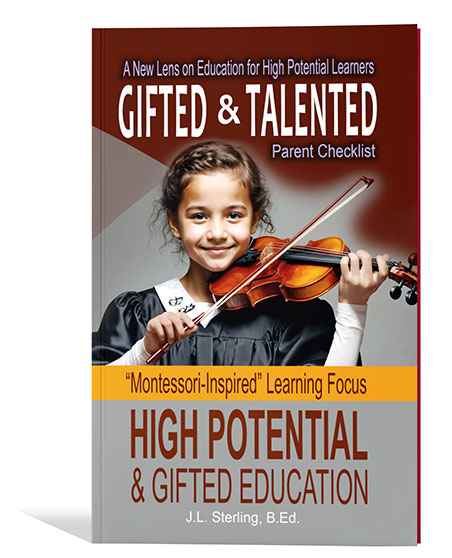High Potential and Gifted Learning
Not Just Smart, But Misunderstood:
Reframing Giftedness Through Montessori and Human Potential
Purchase Options
🛒 Order your copy today from Amazon or Books.by and start unlocking the hidden brilliance in your child or classroom with an approach that honors potential, not just performance.
Interesting for both teachers and parents
This book is a gem. Written by a former teacher with deep insight, it tackles the struggles many parents face when their bright children don’t fit the traditional school mold. It helped me see that boredom and resistance might be signs of giftedness, not problems. I wish I had this book years ago, it would have changed everything.
Education reframed
A must-read for anyone who questions the one-size-fits-all approach in schools. This book reframes giftedness with compassion and clarity. I especially appreciated the real-life stories, the practical tools, and how it honours identity, creativity, and emotion, not just academic scores.
A game-changer for inclusive gifted education
This is not just another education book. It’s a call to see brilliance in all its forms, including kids who don’t test well but shine in emotion, identity, or creativity. The section on DMGT was especially eye-opening, and the Montessori strategies brought it all to life.
Unlocking Hidden Brilliance: A Compassionate Vision for Gifted Education in Modern Classrooms
By J.L. Sterling, B.Ed.
What if giftedness isn’t about grades, but about being seen?
In Gifted and Talented: Montessori-Inspired Learning Focus, veteran educator J.L. Sterling opens a powerful conversation about how schools define, overlook, and support high-potential learners. Drawing from 32+ years in public education and Montessori-inspired environments, this book reimagines gifted education through the lens of humanity, not just performance.
Blending research, real student stories, and international insight, Sterling shines a light on the children who don’t fit the mold - the ones mislabeled as disruptive, withdrawn, or ‘too sensitive’ - and shows how these are often the learners with the deepest capacity to thrive, if supported correctly.
This book is more than theory. It’s a call to action for parents, teachers, and change-makers to look deeper, listen differently, and shift from narrow diagnostics to a fuller understanding of giftedness that includes emotion, identity, and equity.
💡 Inside You'll Discover:
- The emotional and social complexities of gifted and twice-exceptional (2e) learners
- Why many high-potential students are missed due to outdated systems of identification
- How Montessori methods nurture curiosity, agency, and inner motivation
- Global lessons from Australia, Finland, and Singapore that challenge current policy gaps
- A practical checklist for recognizing early signs of giftedness at home and school
- Frameworks for culturally responsive, inclusive, and self-guided education
Whether you're a parent seeking support or an educator questioning how we define brilliance, this book invites you to reframe potential - not as a label, but as a living possibility.
Free Dowloads
YouTube Channel - JL. Sterling
Emotional Highlights from Gifted and Talented
Six pivotal moments that reveal the emotional reality behind misunderstood giftedness and the untapped brilliance hidden in today’s classrooms.
Guilt
“I’d walked past him for weeks. Now I saw it. He wasn’t defiant, he was done. No one had asked him what he could do, only what he hadn’t.”
This quiet moment captures the guilt of overlooking potential that doesn't show up in traditional ways, and the cost of assuming apathy instead of asking deeper questions.
Empathy / Misunderstanding
“She wasn’t failing, she was hiding. Because in her world, to be smart was to be singled out.”
This vignette explores the quiet emotional calculus that many gifted children perform to fit in, and the empathy required to see their avoidance as self-protection, not disinterest.
Fear
“If we keep framing potential through a deficit lens, we will keep creating scared learners instead of supported ones.”
This excerpt expresses the fear that outdated systems may not just overlook brilliance, they may actively push it away under the weight of labels, rigid scores, and behavioral penalties.
Regret
“Years later, I still wonder what he might have become if we had seen him sooner, not after the detentions, but before them.”
A raw reflection on missed opportunities, a call to question how many gifted learners are labeled difficult when they’re actually disillusioned, disengaged, or already defeated.
Loss
“When brilliance is tied to performance, those who shine differently are dimmed. It’s not just potential we lose, it’s a child’s sense of worth.”
A powerful truth about how narrow metrics can suppress more than academic outcomes, they erode identity, belonging, and the right to be seen in full humanity.
Hope / Empowerment
“Giftedness is not a prize, it’s a perspective. And when you change the lens, everything changes.”
This moment reframes what gifted education can become, not a program for the few, but a path to deeper humanity, self-awareness, and growth for all learners.
This Book Doesn’t Label ~ It Liberates Possibility
Some learners shine through grades, others through resistance, curiosity, or emotion.
This book helps you see giftedness where it's been hiding all along ~ in the students often misunderstood.
Let these pages shift how you define brilliance, potential, and the power of being seen.
Start a new conversation in education ~ one led by compassion, not conformity.
